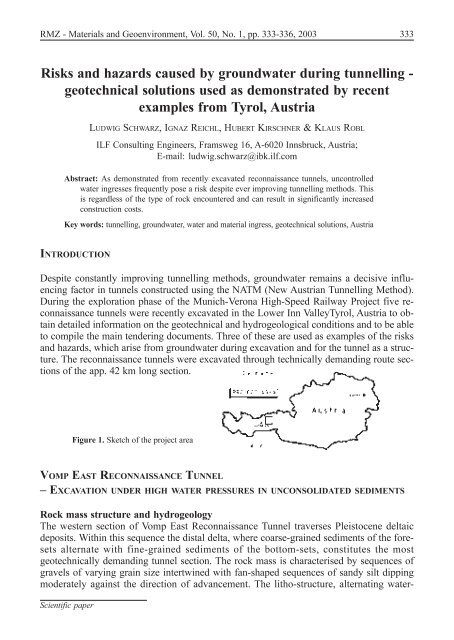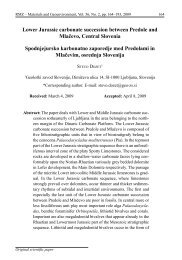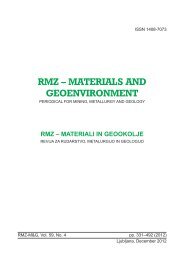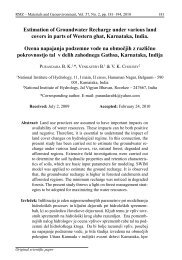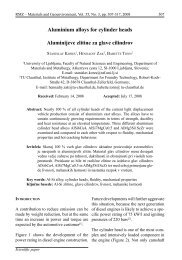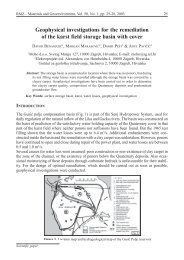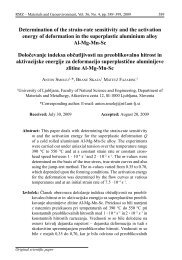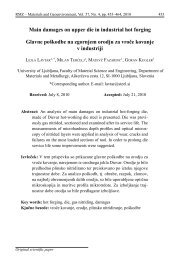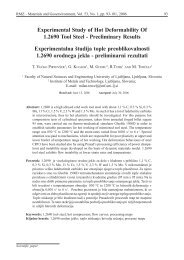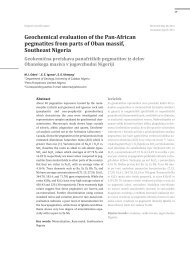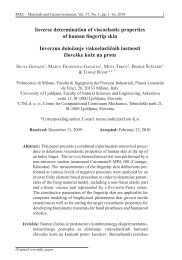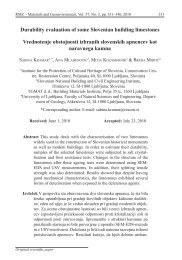Risks and hazards caused by groundwater during tunnelling ... - RMZ
Risks and hazards caused by groundwater during tunnelling ... - RMZ
Risks and hazards caused by groundwater during tunnelling ... - RMZ
You also want an ePaper? Increase the reach of your titles
YUMPU automatically turns print PDFs into web optimized ePapers that Google loves.
<strong>RMZ</strong> - Materials <strong>and</strong> Geoenvironment, Vol 50, No 1, pp 333-336, 2003 333<br />
<strong>Risks</strong> <strong>and</strong> <strong>hazards</strong> <strong>caused</strong> <strong>by</strong> <strong>groundwater</strong> <strong>during</strong> <strong>tunnelling</strong> -<br />
geotechnical solutions used as demonstrated <strong>by</strong> recent<br />
examples from Tyrol, Austria<br />
LUDWIG SCHWARZ, IGNAZ REICHL, HUBERT KIRSCHNER & KLAUS ROBL<br />
ILF Consulting Engineers, Framsweg 16, A-6020 Innsbruck, Austria;<br />
E-mail: ludwigschwarz@ibkilfcom<br />
Abstract: As demonstrated from recently excavated reconnaissance tunnels, uncontrolled<br />
water ingresses frequently pose a risk despite ever improving <strong>tunnelling</strong> methods This<br />
is regardless of the type of rock encountered <strong>and</strong> can result in significantly increased<br />
construction costs<br />
Key words: <strong>tunnelling</strong>, <strong>groundwater</strong>, water <strong>and</strong> material ingress, geotechnical solutions, Austria<br />
INTRODUCTION<br />
Despite constantly improving <strong>tunnelling</strong> methods, <strong>groundwater</strong> remains a decisive influencing<br />
factor in tunnels constructed using the NATM (New Austrian Tunnelling Method)<br />
During the exploration phase of the Munich-Verona High-Speed Railway Project five reconnaissance<br />
tunnels were recently excavated in the Lower Inn ValleyTyrol, Austria to obtain<br />
detailed information on the geotechnical <strong>and</strong> hydrogeological conditions <strong>and</strong> to be able<br />
to compile the main tendering documents Three of these are used as examples of the risks<br />
<strong>and</strong> <strong>hazards</strong>, which arise from <strong>groundwater</strong> <strong>during</strong> excavation <strong>and</strong> for the tunnel as a structure<br />
The reconnaissance tunnels were excavated through technically dem<strong>and</strong>ing route sections<br />
of the app 42 km long section<br />
Figure 1 Sketch of the project area<br />
VOMP EAST RECONNAISSANCE TUNNEL<br />
– EXCAVATION UNDER HIGH WATER PRESSURES IN UNCONSOLIDATED SEDIMENTS<br />
Rock mass structure <strong>and</strong> hydrogeology<br />
The western section of Vomp East Reconnaissance Tunnel traverses Pleistocene deltaic<br />
deposits Within this sequence the distal delta, where coarse-grained sediments of the foresets<br />
alternate with fine-grained sediments of the bottom-sets, constitutes the most<br />
geotechnically dem<strong>and</strong>ing tunnel section The rock mass is characterised <strong>by</strong> sequences of<br />
gravels of varying grain size intertwined with fan-shaped sequences of s<strong>and</strong>y silt dipping<br />
moderately against the direction of advancement The litho-structure, alternating water-<br />
<strong>RMZ</strong>-M&G Scientific paper 2003, 50
334 SCHWARZ, L ET AL<br />
bearing <strong>and</strong> impermeable sequences results in a system of confined water bodies where the<br />
water pressure is between 3 <strong>and</strong> 5 bar (see Fig 2)<br />
Relevance to <strong>tunnelling</strong> methods – <strong>tunnelling</strong> <strong>hazards</strong><br />
When the fine-grained sequences were advanced<br />
onto, hydraulic ground break occurred<br />
Due to the pressure (3 to 5 bar), water ingress<br />
occurred which had large erosive forces, leading<br />
to the formation of cavities of up to several<br />
100 m³ next to the tunnel structure Sudden<br />
failure of the tunnel structure due to redistribution<br />
of rock mass loads would have<br />
been a possible scenario <strong>during</strong> further advancement<br />
Figure 2 Longitudinal cross-section through the delta<br />
facies - Vomp East Reconnaissance Tunnel<br />
Tunnel construction measures<br />
From the available ground investigation data (tunnel <strong>and</strong> core drillings) it soon became<br />
clear that the conditions ahead of the face were not going to change rapidly Injection measures<br />
turned out to be unsuitable due to a high percentage of fine-grained material In the<br />
end it became apparent that tunnel excavation using mining methods in such ground conditions<br />
could only be carried out <strong>by</strong> lowering the <strong>groundwater</strong> table <strong>and</strong> reducing the pressure<br />
The section was finally traversed <strong>by</strong> a combination of drainage drilling ahead of face<br />
<strong>and</strong> pipe arches as support The continuous adjustment of the geological model <strong>and</strong> using<br />
this consequently for the precision drainage drillings proved to be very important<br />
BRIXLEGG WEST RECONNAISSANCE TUNNEL<br />
– HETEROGENEOUS GROUND CONDITIONS AND GROUNDWATER BODIES<br />
Geological model <strong>and</strong> <strong>tunnelling</strong> concept<br />
Over a length of 170 m the Brixlegg West Reconnaissance Tunnel traverses the Matzenpark<br />
Syncline, which is filled with Quaternary ice marginal sediments, a heterogeneous sequence<br />
of s<strong>and</strong>y gravel <strong>and</strong> fine-grained sediments [1] The syncline is in fact a hanging valley, which<br />
joins the over, deepened Inn Valley below the current valley bottom (Fig 3) The varying<br />
litho-structure results in a complex hydrogeological system of slope-water bodies, which intercommunicate<br />
with the Inn Valley Aquifer reaching pressures at tunnel level of up to 15 bar<br />
Tunnelling concept<br />
As the “Matzen Park” is a protected natural area, the public authorities initially required<br />
that no above ground auxiliary construction measures should be used The initial excavation<br />
concept, for crossing the Matzenpark Syncline, foresaw the construction of a continuous<br />
cone of columns around the tunnel with the face shielded <strong>by</strong> a cork-like system using<br />
jet-grouting techniques (Fig 4) As an additional support measure, an injection umbrella<br />
was constructed prior to the jet grouting columns, which was ab<strong>and</strong>oned after a few tunnel<br />
metres<br />
<strong>RMZ</strong>-M&G 2003, 50
<strong>Risks</strong> <strong>and</strong> <strong>hazards</strong> <strong>caused</strong> <strong>by</strong> <strong>groundwater</strong> <strong>during</strong> <strong>tunnelling</strong> - geotechnical solutions 335<br />
Figure 3 Map of the Matzenpark section<br />
Figure 4 Brixlegg West initial <strong>tunnelling</strong> concept<br />
Risk scenario<br />
Difficulties became apparent when the columns could not be constructed in the desired<br />
dimension <strong>and</strong> defective areas led to the danger of water <strong>and</strong> material ingresses At the sixth<br />
cone of columns this scenario became a reality which culminated in development of a 30 m 3<br />
cavity penetrating to ground level After additionally strengthening the ground around the 4<br />
m diameter tunnel <strong>by</strong> means of grouting the tunnel excavation was continued Further problems<br />
in the construction of the jet-grouting columns finally made the client ab<strong>and</strong>on this<br />
excavation concept due to safety problems <strong>and</strong> high costs<br />
New tunnel construction concept <strong>and</strong> measures<br />
Due to the encountered problems, the public authorities were convinced of the necessity of<br />
above ground auxiliary measures Sealing off the Matzenpark Syncline from the Inn Valley<br />
Aquifer allowed this difficult section to be finally <strong>and</strong> successfully advanced<br />
BRIXLEGG EAST RECONNAISSANCE TUNNEL<br />
– EXCAVATION IN HARD ROCK CONTAINING WATER-BEARING FAULT ZONES<br />
FILLED WITH UNCONSOLIDATED MATERIAL<br />
Geologic model<br />
Shortly before the planned end of the Brixlegg East Reconnaissance Tunnel, the drilling of<br />
an anchor hole was accompanied <strong>by</strong> an ingress of water (25 l/s) <strong>and</strong> a flushing out of a few<br />
cubic meters of material At this point the tunnel was situated in a sequence of carbonates<br />
with an increasing degree of fracturing within the rock mass The ensuing reconnaissance<br />
programme revealed a fault zone of up to several tens of meters thickness filled in part with<br />
unconsolidated material This fault zone was prognosed to cross the excavation line, at a<br />
low angle, a few meters ahead of the tunnel face Furthermore, the investigations revealed<br />
that the fault zone was highly permeable containing water at pressures of up to 50 bar The<br />
findings pointed to the following scenarios: 1) Impacts on the stability of tunnel structure<br />
due to large-scale flushing out of material <strong>and</strong> the resulting change in load distribution<br />
within the rock mass, 2) Impact on <strong>groundwater</strong> aquifers <strong>and</strong> especially on the adjacent spawater<br />
aquifer, <strong>and</strong> 3) Danger to <strong>tunnelling</strong> crew due to water ingresses in combination with<br />
large-scale flushing out of material<br />
<strong>RMZ</strong>-M&G 2003, 50
336 SCHWARZ, L ET AL<br />
Figure 5 Map of the Brixlegg East fault zone<br />
Tunnelling solution<br />
In order to master this fault zone, the client explored alternative excavation concepts During<br />
an injection test aimed at improving the geotechnical properties of the fault an app 500 m³<br />
zone was grouted using 330 t of cement This test did not lead to the desired result, namely the<br />
successful resumption of <strong>tunnelling</strong> [3] In addition, two draw-down tests were carried out in<br />
order to investigate the possibilities of lowering the <strong>groundwater</strong> table <strong>and</strong> exploring the<br />
effects An extensivehydrological/geotechnical monitoring <strong>and</strong> testing programme was pursued<br />
to investigate the <strong>groundwater</strong> properties <strong>and</strong> to evaluate the impacts on the <strong>groundwater</strong><br />
system <strong>and</strong> the above mentioned spa-water aquifer On the one h<strong>and</strong>, the results showed<br />
that artificial draw-down could be used to master the fault zone, on the other h<strong>and</strong> they also<br />
provided clear proof of a quantitative <strong>and</strong> qualitative but reversible impact on the spa-water<br />
aquifer, which is why <strong>tunnelling</strong> has not been resumed for the time being [2] <br />
CONCLUSIONS<br />
As demonstrated <strong>by</strong> recently excavated reconnaissance tunnels, water ingresses pose a major<br />
risk to the excavation <strong>and</strong> tunnel structure despite modern <strong>tunnelling</strong> techniques A flexible<br />
adjustment of the excavation concept, using the NATM in general, allows such situations to<br />
be h<strong>and</strong>led successfully<br />
REFERENCES<br />
[1]<br />
EDER, S, POSCHER, G, SCHWARZ, L (2003): Geotechnical <strong>and</strong> hydrogeological models used for <strong>tunnelling</strong> in<br />
quaternary sediments: Examples from the “Northern Feeder Line”, Railway-Axis Brenner 14 Tagung für<br />
Ingenieurgeologie, pgs 77-82, Kiel, Germany<br />
[2]<br />
MAMMEL, R, REICHL, I, SCHWARZ, L, FISCH, H (2003): Does <strong>groundwater</strong> pose a risk to underground structures,<br />
or do underground structures pose a risk to potential <strong>groundwater</strong> resources 1st International<br />
Conference (IAH) on Groundwater in Geological Engineering, Bled, Slovenia, 22-26 September 2003<br />
[3]<br />
REICHL, I, R WOLLMARKER, G STADLER, K SCHRETTER, EDER, E (2002): Erkundungsstollen Brixlegg Ost,<br />
Beispiel für die Grenzen der Wirksamkeit von Felsinjektionen Proc 17 Christian Veder Kolloquium,<br />
pgs 177 – 192, Graz, Austria<br />
<strong>RMZ</strong>-M&G 2003, 50


